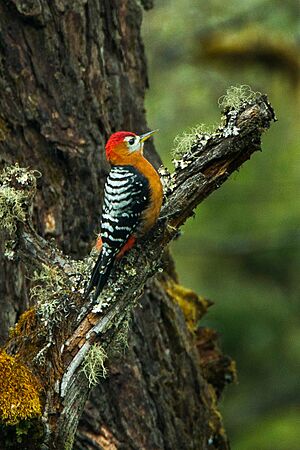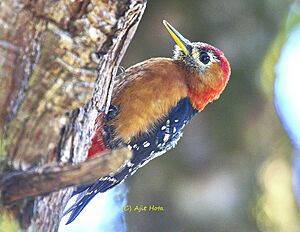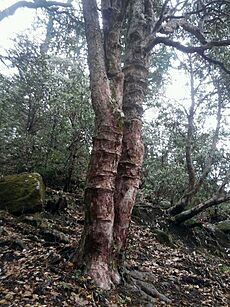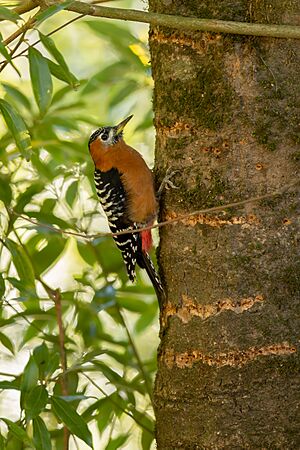Rufous-bellied woodpecker facts for kids
Quick facts for kids Rufous-bellied woodpecker |
|
|---|---|
 |
|
| Male in Bhutan | |
| Conservation status | |
| Scientific classification | |
| Genus: |
Dendrocopos
|
| Species: |
hyperythrus
|
| Synonyms | |
|
Hypopicus hyperythrus |
|
The rufous-bellied woodpecker (Dendrocopos hyperythrus) is a cool bird that lives in forests across parts of Asia. It's also sometimes called the rufous-bellied sapsucker because of a special way it eats! This woodpecker belongs to the family of birds called Picidae, which includes all woodpeckers.
You can find this bird in many countries. These include Bangladesh, Bhutan, Cambodia, Hong Kong, India, Korea, Myanmar, Nepal, Thailand, and Vietnam. It likes to live in warm, wet forests, especially in mountains.
What Does It Look Like?
The rufous-bellied woodpecker is about 19 to 23 centimeters (7.5 to 9 inches) long. That's about the size of a small ruler!
Male and female woodpeckers look a little different. The male has a bright red top of its head. The female has a black head with small white spots.
Both male and female birds have a black back and wings. Their wings have white stripes. Their tail is black, with some white on the outer feathers. Their face is white, and their throat and belly are a cinnamon or reddish-brown color. The lower part of their belly has black and white stripes. The feathers under their tail are red or pink.
Their eyes are chestnut brown. The top part of their beak is black, and the bottom part is grey. Their legs are grey or olive green.
How Does It Eat?
This woodpecker has a special tongue. The tip of its tongue looks like a brush. This helps it drink sap from trees. Sap is like the tree's juice.
It often looks for sap in the spring. During other times of the year, it eats insects that live in wood or under bark. It might even use the same trees to get sap year after year. This can leave rings on the tree trunks.
Is It Endangered?
The rufous-bellied woodpecker lives in many places. However, it is not a very common bird. It has disappeared from some areas where it used to live. This is because the forests it needs are being cut down.
Scientists think the number of these woodpeckers is going down. But the International Union for Conservation of Nature (IUCN) has looked at its status. They say it is a "least concern" species. This means it is not in immediate danger of disappearing.





